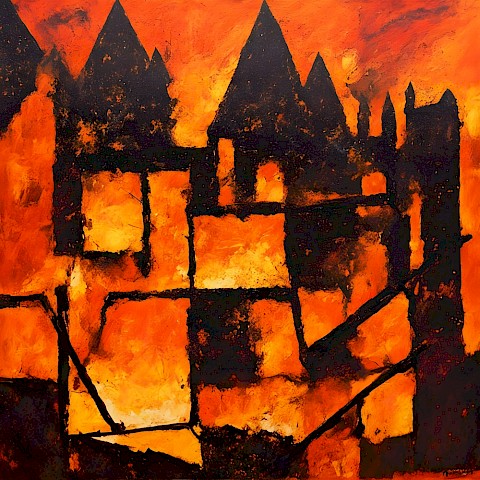|
28 VIII 2025 |
14. Exhibited Oil Paintings 1830-50
512 - The Burning of the House of Lords and Commons, 16th of October, 1834 | |

| ||
|
One of the two oil paintings of this subject exhibited in 1835; the other, taken from a more distant viewpoint down river, was exhibited at the Royal Academy and is now in the Cleveland Museum of Art. For the watercolours done at the time and subsequently see Nos. 456-60. This is one of the paintings for which there are eyewitness accounts of Turner's activity on the Varnishing Days before the opening of the exhibition to the public. 'The picture sent in was a mere dab of several colours and "without form and void" , like chaos before the creation,' wrote E. V. Rippingille (see Finberg 1961, pp.351-2, for a fuller version); 'for the three hours I was there - and I understood it had been the same since he began in the morning - he never ceased to work, or even once looked or turned from the wall on which his picture was hung. A small box of colours, a few very small brushes, and a vial or two, were at his feet. ... In one part of the mysterious proceedings Turner, who worked almost entirely with his palette knife, was observed to be rolling and spreading a half-transparent stuff over his picture, the size of a finger in length and thickness. As Callcott was looking on I ventured to say to him "What is that he is plastering his picture with ?" to which inquiry it was replied "I should be sorry to be the man to ask him." ... Presently the work was finished: Turner gathered his tools together, put them into and shut up the box, and then, with his face still turned to the wall, and at the same distance from it, went sidelong off, without speaking a word to anybody. •.. Maclise, who stood near, remarked, "There, that's masterly, he does not stop to look at his work; he knows it is done, and he is off"!' The Spectator for 7 February 1835 made allusion to this activity of Turner's: 'And the execution of the picture is curious: to look at it close, it appears a confused mass of daubs and streaks of colour; yet we are told the painter worked at it within a few inches of the canvas for hours together, without stepping back to see the effect. Turner seems to paint slovenlily [sic] - daubing, as one would say; yet what other painter preserves equal clearness of colour? Not that we like this scenepainting manner; we should prefer being able to look at a picture near as well as at a distance; but such a one as this we are content to look at in any way the artist chooses - with all its faults.' The Spectator went on to point out that the picture stood out from its neighbours through its 'purity, transparency, and harmony of colouring', not through its 'quantity or intensity'. It praised the various effects of light, with the qualification that 'There is an effect of daylight in the picture, however, which is not counterbalanced by the gaslamp in the foreground', and that the figures were too bad for one to distinguish whether they were 'Christians or Pagans, fine ladies or coalheavers'. The Times for 10 February also asserted that 'The sky is painted in much too light a tint, and is more applicable to a morning than a night scene', and the Athenaeum for 14 February called the picture 'a splendid impossibility' for the same reason; 'truth is sacrificed for effect, which, however, is in parts of the picture, magnificent' . However, the Literary Gazette for 14 February pointed out that Turner had achieved his effects 'not by any striking opposition of light and dark', but by 'the contrast of warm and cold, of the blazing flame and of the early morning' morning'. Turner was later to use a similar contrast for emotional effect in 'The Fighting Temeraire' (National Gallery, London, 524). The Literary Gazette summed up the picture as manifesting 'quite as much of vision and poetry as of nature'. A later issue, on 25 April, noted that the picture had been bought by C. Hall, and by 1852 it belonged to Charles Birch of Edgbaston. An image generated by an AI Machine Learning Model Property of the artist. | ||
